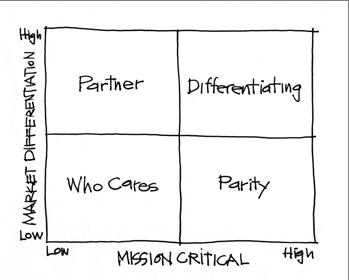
Lean in close so that I can share with you my secret for leading the digital transformation of the enterprise. It turns out that there is a repeatable formula for successfully pulling off the transformation of any organization on the face of the earth. The formula has the following four components:
• Focus innovation only on what creates sustainable competitive advantage for your organization
• Mimic best practices, simplify and standardize everything that does not directly create sustainable competitive advantage
• Loosely couple everything (after all, everything is likely to change and we do not have the time to break tight coupling of systems and business practices)
• Redefine the role of leadership – leaders create cultures that unleash talent and great work. Such cultures are built on trust and ownership
The first two components of the formula apply directly to the selection and implementation of ERP. I have personally led five (with the sixth underway) and advised about twenty other organizations on their selection and implementation of their ERP. The most important lesson I have learned along the way is that the vast majority (if not all) of ERP functionality does NOT deserve innovation because it is highly unlikely that ERP functionality will ever create sustainable competitive advantage for any organization.
Let me explain by introducing a model I developed some time ago (and have proven through my various ERP experiences). I call this the Purpose Alignment Model and it looks like:
 Using this model, we evaluate every activity in two dimensions – to what extent will the activity create market differentiation and to what extent is the activity mission critical? If we filter our activities (business rules, functionality, features, et cetera) using these two dimensions, we end up with four types of activities:
Using this model, we evaluate every activity in two dimensions – to what extent will the activity create market differentiation and to what extent is the activity mission critical? If we filter our activities (business rules, functionality, features, et cetera) using these two dimensions, we end up with four types of activities:
Differentiating – these are the market-differentiating / mission-critical things we do that create our sustainable competitive advantage. These are the things we do better than anyone else in the marketplace. This is what we do to win (today and forever) in the marketplace. And, these are the only things that deserve our innovation and creativity. Going back to my formula for digital transformation, we focus all of our organization only on these things. Every organization has at least one and possibly two Differentiating activities but never more than three (do you really think that you can be better than everyone else at more than three things? Well, you are wrong.)
Parity – these are the mission-critical transactions like accounting, supply chain management, customer case management, pricing, hiring, inventory management, network management, et cetera that we cannot live without but are not the reason people choose our products and services over all of the alternatives. There is never a reason to invent parity activities – someone has already figured out the best way to do these things. Parity activities represent the vast majority of the work done in our organizations. Thus, we can significantly improve value if these activities are simple, standard and risk- and error-free. My favorite example of a parity activity is accounts receivable. It is highly unlikely that we create competitive advantage because we have a unique, elegant approach to sending an invoice. What is the goal of an invoice? To get paid. It should not take some home-grown or customized ERP to deliver a “good-enough” invoice. We just want to make sure that the invoice is timely and correct and any ERP worthy of consideration can generate an accurate and timely invoice.
Partner – there might be something that creates competitive advantage for us but is not in our mission-critical “wheelhouse.” For these, we find a partner and together we create competitive advantage. However, it is worth noting that these partnering opportunities are rare and should be temporary – ultimately, we have to own what creates our competitive advantage.
Who Cares – we should minimize the time and effort we spend on things that are neither market differentiating nor mission critical.
Let us now apply this model to ERP selection and implementation. I will start with a bold statement (and you can then try to prove me wrong): Any market-leading ERP has the functionality to deliver parity transactions at the appropriate level. Therefore, there is never a reason to customize any ERP functionality. If your process for accounts receivable or inventory management or procurement is not supported by the functionality of a market-leading ERP, you are doing accounts receivable or inventory management or procurement better than it has to be done and you should abandon the way you are doing such things and do them the ERP way. After all, that ERP provider has to deliver functionality based on known best practices. Rather than customizing ERP to make it conform to your business practices, you conform your business practices to the ERP.
Using this thought process, you should never use functionality to make your ERP selection and implementation decisions. How do you then select ERP? On criteria such as:
- Time-to-benefit (which system is the simplest and fastest path to the realization of the benefits?)
- Ease of use (which one delivers a better user experience?)
- Integration with critical elements of your eco-system
- Total cost of ownership
- Product roadmap and futures
- Provider’s investment in future technology and functionality
Too often I see organizations spend way too much time, effort and money as they customize ERP to match the way they do things today. To justify and maximize the investment, never do ERP to replicate what you have (if that is what you want to do, keep what you already have). Instead use ERP to help you achieve operational excellence of your parity activities by adopting best practices (as embodied in a market-leading ERP) and simplifying and standardizing all of your parity transactions.







































